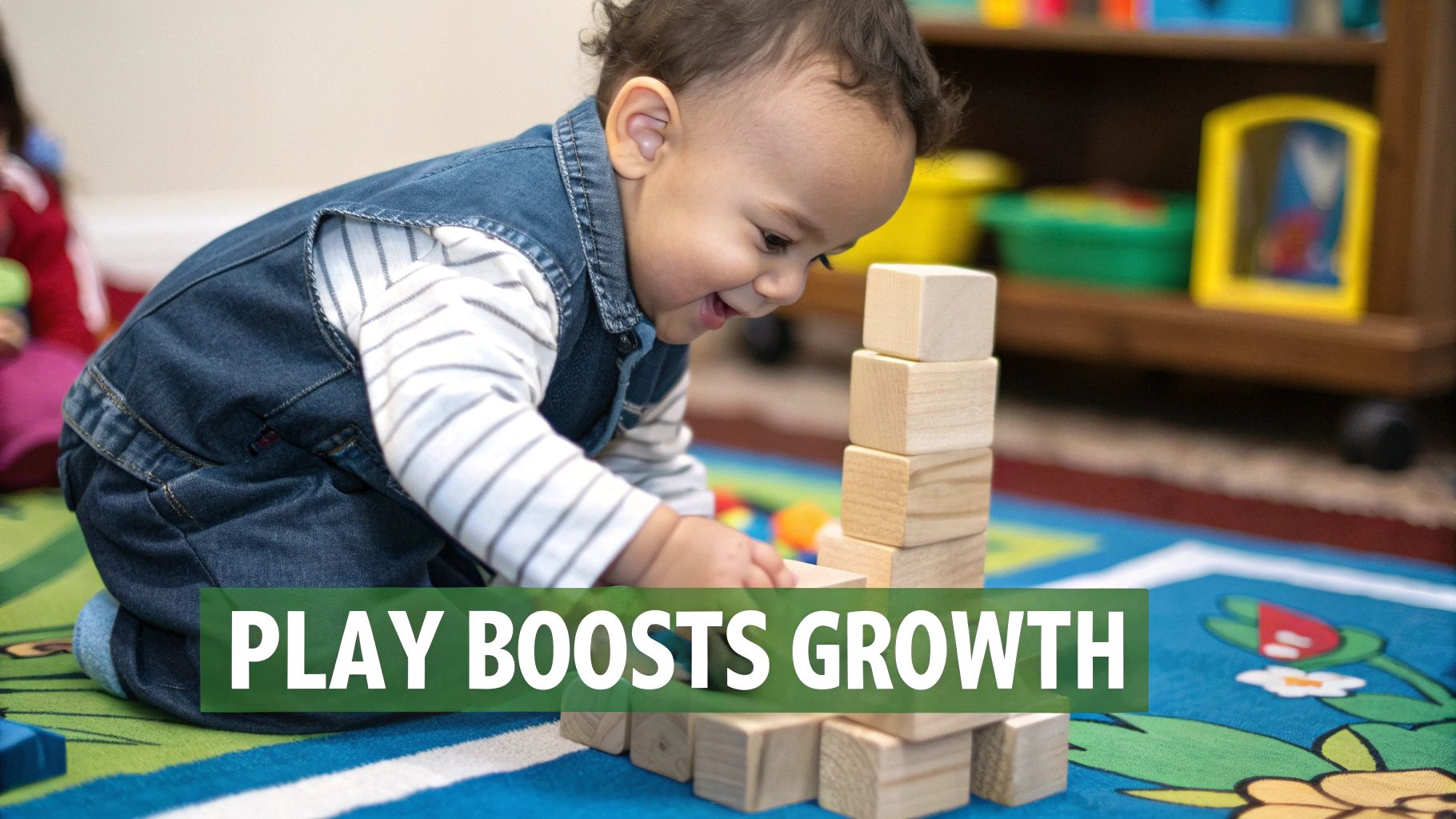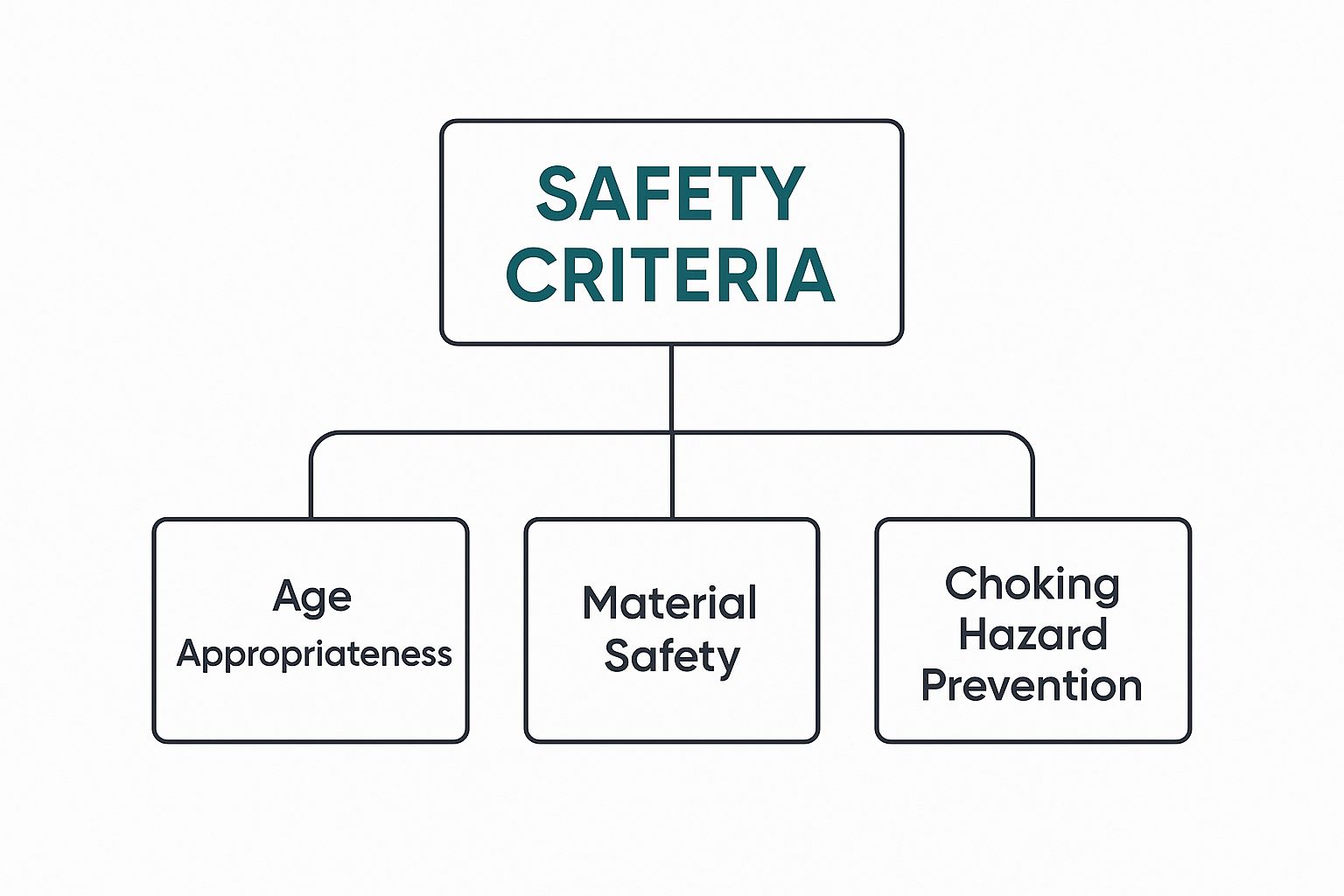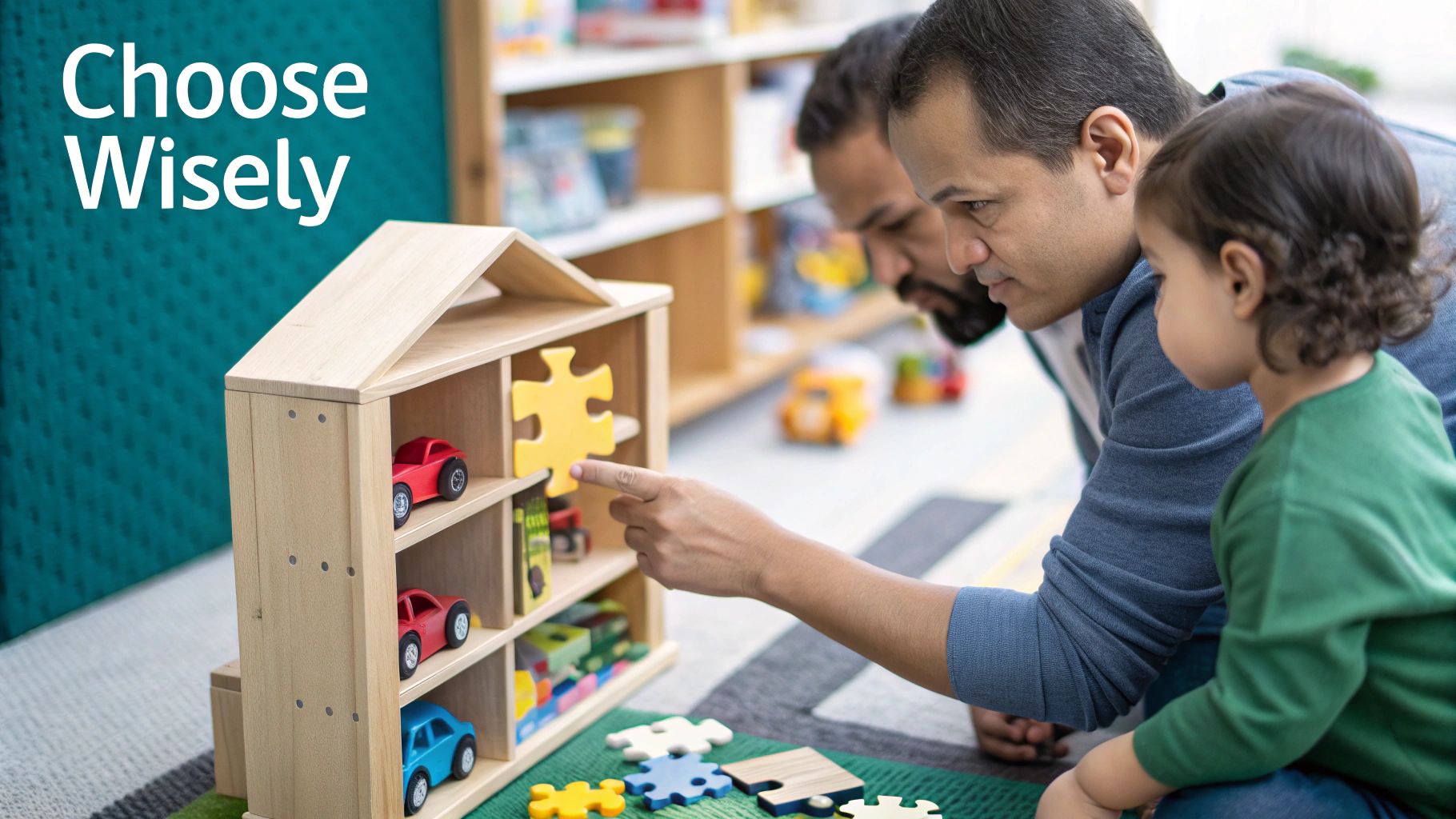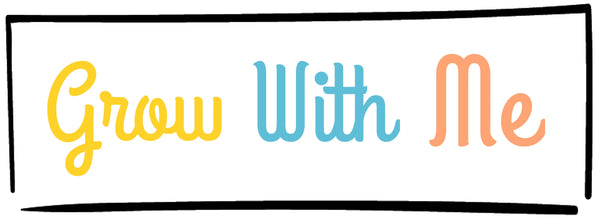
Educational Toys for One Year Olds A Parent's Guide
Share
When it comes to the best educational toys for a one year old, simple is often best. Look for toys that encourage open-ended play rather than gadgets that only do one thing. Timeless classics like stacking rings, chunky shape sorters, and sturdy push walkers are perfect because they invite exploration and help build those crucial early skills.
Why Your One Year Old Is Ready for Educational Toys

That first birthday feels like a switch has been flicked. The baby who was happy to just watch the world go by is suddenly a determined little explorer, driven by an almost unstoppable curiosity to touch, taste, and test everything in sight. This isn't just random mischief; it’s a sign of a huge developmental explosion, both physically and mentally.
Think of your one-year-old as a tiny scientist, and your living room is their laboratory. Every object they get their hands on becomes a new experiment. When they drop their spoon from the highchair for the tenth time, they're not really trying to test your patience. They're figuring out gravity and the fascinating concept of cause and effect.
A Brain Built for Discovery
What's happening behind the scenes is even more amazing. Around this age, your toddler's brain is forming more than a million new neural connections every single second. This incredible wiring process is powered by every single sensory experience they have.
The rough texture of a wooden block, the jingle of a rattle, the sight of a colourful ball rolling just out of reach – these are all vital bits of data their brain is busy processing. This is exactly why play is so often called the "work of childhood." It's how your little one makes sense of the world and builds the very foundations for all future learning.
"For a small child, there is no division between playing and learning; between the things he or she does 'just for fun' and things that are 'educational.' The child learns while living and any part of living that is enjoyable is also play." - Penelope Leach
Key Developmental Leaps at One Year
This exciting stage is marked by several huge milestones, and the right toys can make all the difference in supporting them. Understanding these changes helps you see why certain educational toys for a one year old are so brilliant at this age.
- Fine Motor Skill Refinement: They’re moving on from a clumsy grab to mastering the pincer grasp—that delicate ability to pick up small things between their thumb and forefinger. This is the bedrock for future skills like holding a crayon or using a zip.
- Gross Motor Skill Development: This is the age of movement! Many are pulling up to stand, cruising along the sofa, and some are even taking those first wobbly steps. Toys that encourage them to get up and go are vital right now.
- Cognitive Growth: Their understanding of the world is deepening. They're starting to grasp object permanence (the idea that you still exist when you're playing peek-a-boo) and are beginning to connect actions with results.
By choosing toys that line up with these natural developmental surges, you’re doing so much more than just keeping them busy. You’re giving your little scientist the perfect tools to carry out their most important experiments, building a rock-solid foundation for a lifetime of learning.
How to Spot a Genuinely Educational Toy

Walking down the toy aisle can feel a bit overwhelming. It seems like every box is plastered with the word "educational," but what does that really mean for a one-year-old? It's not about flashing lights or toys that sing the alphabet on command; it's about giving them tools for genuine discovery.
A truly educational toy is a developmental partner, not just a flashy gadget. Think of it this way: a toy that plays a tune when a button is pressed teaches a very simple lesson about cause and effect. But a set of simple wooden blocks? That teaches the same lesson, plus the basics of physics, spatial awareness, creativity, and fine motor skills all at once. The best toys are always 90% child and 10% toy—meaning your little one is in charge of the play, not the other way around.
The Power of Open-Ended Play
The secret to spotting a brilliant toy is asking one simple question: how many different things can my child do with this? This is the heart of open-ended play. Toys that can be stacked, sorted, hidden inside each other, or used for make-believe are developmental gold.
And it seems parents are catching on. The educational toy market for toddlers aged 1-3 is now the biggest slice of the pie, making up around 51% of the total market share. It’s a clear sign that we're moving towards toys that mix fun with real developmental value. You can read more about this shift over at Grand View Research.
A truly educational toy doesn’t shout instructions. It whispers, “What can you do with me?” It’s an invitation to create, to solve problems, and to explore.
This idea is at the core of so many brilliant early learning philosophies. If you’re drawn to this style of play, you might find it interesting to learn more about how Montessori toys for toddlers put these exact principles into practice.
Your Mental Checklist for Choosing Toys
To help you cut through the marketing noise, it’s useful to have a mental checklist. Keeping these points in mind will help you pick out toys that will genuinely earn their place in the playroom.
1. Safety and Durability First
At this age, everything goes straight into the mouth. So, before anything else, you need to know a toy is safe for them to explore.
- Non-Toxic Materials: Look for toys made from natural materials like wood with non-toxic paints, or high-quality, BPA-free plastics.
- No Small Parts: Are there any bits that could break off and become a choking hazard? A good rule of thumb is that if a piece can fit inside a toilet paper tube, it’s too small for a one-year-old.
- Sturdy Construction: The toy needs to be tough enough to handle being dropped, thrown, and gummed on without falling to pieces.
2. Multi-Sensory Engagement
One-year-olds learn about their world with all their senses. A fantastic toy will appeal to more than just their eyes. It might have a smooth, warm wooden texture, make a gentle rattle when shaken, or feature simple, contrasting colours that are easy for developing vision to focus on. This kind of multi-sensory feedback is what builds those all-important neural connections in their growing brain. By looking for these core qualities, you can be sure the educational toys for your one year old are truly helping them grow.
Matching Toys to Your Toddler's Development
So, you know what makes a good toy in principle. Now for the fun part: matching that knowledge to where your little one is right now. This is how you turn theory into real-world, playful learning. When you understand the key developmental milestones for a one-year-old, you can choose toys that are less like distractions and more like perfect partners in their growth.
Think of it less like random shopping and more like picking the right tool for a specific job. You wouldn't use a screwdriver to bang in a nail, right? In the same way, a toddler who is perfecting their pincer grasp needs a toy that encourages that delicate movement, while another who’s just starting to walk needs something to support their balance.
Supporting Fine Motor Skills
Around their first birthday, your child’s hands are becoming remarkably dextrous. They’re moving past that clumsy whole-hand grab and are starting to master the delicate pincer grasp—using their thumb and forefinger to pick up small things. This is a massive step, laying the groundwork for everything from feeding themselves to one day holding a crayon.
The best educational toys for a one year old to help with this are things that invite them to poke, place, and twist.
- Shape Sorters: A true classic for a reason! They get your child to really think about how to turn and manipulate a shape to fit it through the right slot.
- Stacking Rings: Sliding rings onto a post takes a surprising amount of concentration and hand-eye coordination.
- Chunky Puzzles: Simple puzzles with big, easy-to-grab knobs are absolutely perfect for practising that pincer grip.
These aren't just games; they are tiny workouts for the small muscles in their hands, building the dexterity they'll rely on for years to come.
Encouraging Gross Motor Skills
This is the age of big, wobbly movements! Your little one is likely pulling themselves up on the furniture, cruising along the sofa, and maybe even taking those first incredible steps. It’s all about building strength, finding their balance, and gaining the confidence to be mobile.
Toys that get them up and moving are your best friend here. Push walkers, for instance, offer just enough stability to help them practise walking, giving them the support they need to explore on their own two feet. Pull-along toys are also fantastic, as they motivate toddlers to walk and even look behind them, which is a clever way to help develop balance and spatial awareness.
The right toy doesn't just entertain; it meets your child exactly where they are in their development and gives them a gentle, playful nudge forward.
Fostering Cognitive Leaps
Your one-year-old's brain is an absolute powerhouse of new connections. They're starting to grasp big concepts like object permanence—the amazing realisation that something still exists even when they can't see it. This is precisely why they adore peek-a-boo and get such a kick out of repeatedly dropping things from their highchair!
To help you see how it all connects, I've put together a quick reference table.
Matching Toys to Your One Year Old's Development
This table breaks down some of the key milestones you'll be seeing around this age and pairs them with the types of toys that will best support that specific area of growth.
| Developmental Milestone | Description | Ideal Toy Examples |
|---|---|---|
| Pincer Grasp | Using the thumb and forefinger to pick up small items. | Chunky puzzles with knobs, stacking rings, shape sorters. |
| Gross Motor Skills | Pulling to stand, cruising, and taking first steps. | Push walkers, pull-along toys, soft play climbers. |
| Object Permanence | Understanding that objects exist even when out of sight. | Peek-a-boo games, lift-the-flap books, pop-up toys. |
| Problem-Solving | Figuring out simple cause-and-effect relationships. | Activity cubes, simple musical instruments (e.g., a drum), toys with buttons that create sounds or lights. |
| Language Development | Babbling, imitating sounds, and understanding simple words. | Picture books, animal sound toys, toy telephones. |
By consciously choosing toys that align with these developmental stages, you're not just buying another thing to clutter up the living room—you're providing a valuable tool for their learning journey.
This image highlights the crucial safety criteria to keep in mind when choosing any toy.

As you can see, focusing on age-appropriateness, safe materials, and preventing choking hazards are the three pillars of a safe toy choice. And if you're looking to engage their senses even more, you can learn more in our guide to sensory toys for babies. By thoughtfully matching toys to these developmental areas, you are actively supporting your child's incredible journey of discovery.
The Best Educational Toy Categories for One Year Olds

Now that you know what makes a toy genuinely educational, let’s look at the must-have categories. These are the classics that have stood the test of time for a reason—you see them again and again because they perfectly match what a curious one-year-old needs to thrive. Think of them as the true powerhouses of the playroom.
Choosing the right type of toy is like giving a craftsperson the perfect tool for the job. Each category targets a different, yet equally vital, area of your child's growth, from big cognitive leaps to those all-important physical milestones.
Building and Stacking Toys
When you picture an educational toy, what’s the first thing that comes to mind? For most of us, it’s building blocks. Simple blocks, stacking rings, or nesting cups are foundational tools for learning, and they’re far more complex than their simple shapes suggest.
As your little one tries to balance one block on another, they’re actually conducting a mini-physics experiment. They’re getting a hands-on lesson in balance, gravity, and spatial awareness. The simple act of sliding rings onto a post teaches them about size, sequence, and order—the very first seeds of mathematical thinking.
It’s no wonder these toys are a firm favourite. In a 2023 market insight, it was found that more than 54% of British shoppers buy building blocks for children, making it the most popular toy category. Right behind are plush toys, bought by nearly 49% of shoppers, which are brilliant tools for early social-emotional development. You can discover more insights about these toy industry trends.
Shape Sorters and Chunky Puzzles
These toys are brilliant for honing fine motor skills and sparking early problem-solving. A shape sorter isn’t just about shoving a star into a star-shaped hole. It’s about trial and error, mentally rotating objects, and that satisfying "click" when they finally figure it out.
A great puzzle or shape sorter teaches a child that persistence pays off. It builds not just cognitive skills, but resilience and confidence.
For a one-year-old, the best puzzles have large, chunky pieces with knobs for easy gripping. This design is perfect for strengthening their pincer grasp, a crucial skill they’ll need later for everything from holding a crayon to doing up a zip.
Push and Pull Toys
As your toddler gets steadier on their feet, push and pull toys become fantastic companions. A sturdy push walker offers the stability they crave while practising those first wobbly steps, building confidence with every single stride. It’s a wonderful way to give them a sense of independence while supporting their gross motor development.
Pull-along toys offer a different, but equally important, challenge.
- Coordination: They encourage your child to walk forward while looking behind them—a surprisingly complex task that improves balance and coordination.
- Cause and Effect: They quickly learn that their action (pulling the string) makes the toy follow them. This is a powerful, concrete lesson in cause and effect.
- Spatial Awareness: Trying to navigate around the coffee table with a toy trailing behind is a great lesson in understanding their body in relation to the space around them.
Each of these classic categories offers layers of learning disguised as simple fun. By including a mix of these educational toys for your one year old, you create a rich play environment that supports their whole development—from their hands to their head to their heart.
Unlocking Learning Through Interactive Play
Choosing a great toy is one thing, but the real magic happens when you get down on the floor and play with them. Your involvement is the secret ingredient that turns a simple toy into a brilliant learning tool. It’s less about the object itself and more about the shared moments of discovery.
With a few simple approaches, you can transform playtime and really boost its developmental power. When you become your child's play partner, you’re giving them the context and connection they need to make sense of the world.
Become Their Narrator
One of the easiest and most powerful things you can do is simply talk about what’s happening. As they play, describe what they’re doing, seeing, and touching. Instead of just watching them stack blocks, you might say, "Wow, you put the big, red block right on top of the small, blue block!" This tiny act builds huge connections in their brain, linking words to actions.
You can do this with anything. Talk about textures ("That teddy feels so soft!") or sounds ("Listen to that little jingle!"). This steady stream of language is like planting seeds; you’re giving their vocabulary everything it needs to grow.
A toy can teach a child about shapes, but a parent can teach them how to share, how to persevere, and how to find joy in solving a problem together.
Guide, Don't Take Over
Asking simple questions is another wonderful way to get their little cogs turning. Things like, "Where did the yellow car go?" or "Can you find the triangle?" encourage them to think and problem-solve without you just giving them the answer. It’s not a test; it’s about gently guiding their curiosity and celebrating their attempts.
You can also show them new ways to play. If they only ever bang two blocks together, take a moment to build a small tower yourself. A simple demonstration can spark their imagination and open up a whole new world of possibilities, encouraging more creative play. If you're using visual aids like flashcards, you can get some great ideas for using flash cards for the alphabet in your games together.
The Power of Less
Finally, it’s so important to remember that less is often more, especially when it comes to educational toys for a one year old. A room crammed with toys can be really overwhelming for a toddler. They often end up just flitting from one thing to the next without ever really getting stuck in.
- Toy Rotation: Try keeping just a small selection of toys available and put the rest away. Every week or two, swap them out. This makes old toys feel exciting and new all over again.
- Focused Play: With fewer options, your child is far more likely to explore what a single toy can do, leading to deeper, more concentrated play.
By carefully choosing what’s available and getting involved in the fun, you create the perfect space for your child to learn and thrive.
Common Questions About Educational Toys
There’s always a moment when parents stare at aisles full of colourful gadgets and wonder where to begin. You want toys that spark curiosity, not chaos. These answers will help you sort through the clutter.
How Many Toys Does a One Year Old Need
One-year-olds do best with fewer options that they can really explore. Focus on quality over quantity by choosing about 8-10 high-quality, open-ended toys. Rotating items every week or two keeps playtime feeling fresh and helps your child dive deeper into each toy.
A minimalist approach to toys gives your child the mental space to explore each item’s full potential, fostering creativity and a longer attention span.
Are Wooden Toys Better Than Plastic Ones
Neither material wins by default, but each brings its own strengths:
- Wooden Toys: Sturdy and tactile, they invite children to imagine new stories with every block or figure. The natural grain and weight add another sensory layer that’s hard to match.
- Plastic Toys: Lightweight and vibrant, these are often easier to clean and can include playful features like sounds or spinning parts. Just choose BPA-free designs for safety.
A balanced playroom that blends both textures will offer the richest experiences.
Should I Avoid Toys With Batteries
Electronic toys shouldn’t run your show, but the right ones can be educational. Aim for gadgets that respond to your child’s input—think a small keyboard where they trigger each note rather than a toy that auto-plays a tune. This keeps them in charge of the action and turns passive watching into active making.
A well-rounded toy box blends child-powered favourites with a few carefully chosen electronic friends.
Feeling overwhelmed by the choices? Grow With Me makes everything simple. Each expertly curated, stage-based play kit arrives ready to go, so you can skip the guesswork and watch your little one thrive. Discover your first kit today at Grow With Me.
